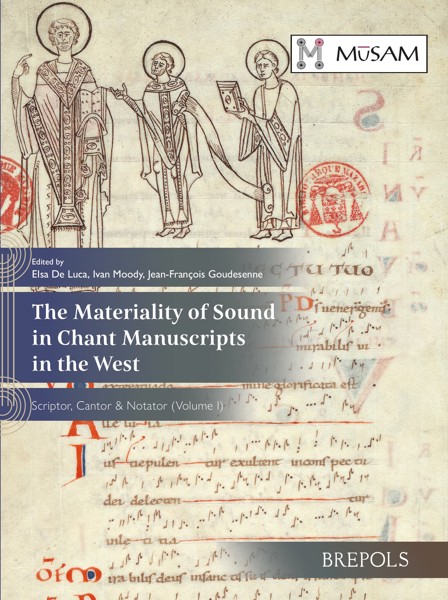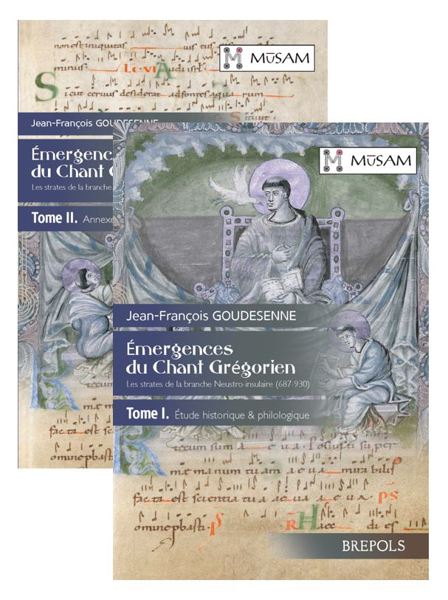
The Materiality of Sound in Chant Manuscripts in the East
Elsa De Luca, Ivan Moody, Jean-François Goudesenne (eds)
- Pages: 280 p.
- Size:216 x 280 mm
- Illustrations:142 b/w, 11 col., 24 tables b/w., 7 tables col.
- Language(s):English, French, Italian
- Publication Year:2025
- € 99,00 EXCL. VAT RETAIL PRICE
- ISBN: 978-2-503-61009-2
- Paperback
- Available
- € 99,00 EXCL. VAT RETAIL PRICE
- ISBN: 978-2-503-61010-8
- E-book
- Available
A new, innovative and interdisciplinary collection of essays by leading scholars in two volumes dealing with chant transmission and manuscripts in both East and West, this publication is the first of its kind in the wide scope, both geographical and historical, of the variety of traditions it covers.
Elsa De Luca (cesem-fcsh NOVA University, Lisbon) is an early music scholar pursuing research on medieval chant notations; she is also engaged in developing tools for computer-assisted research in early music.
The late Ivan Moody (cesem-fcsh– NOVA University, Lisbon) was a composer, musicologist and Orthodox priest. At the time of his passing, he was actively involved in several research projects dealing with music in the Mediterranean and the Balkans.
Jean-François Goudesenne is a researcher at the Institut de Recherche et d’Histoire des Textes (CNRS), in the musicology section, founded by Michel Huglo in 1979. His most important contribution is the discovery of the Western dialect of Gregorian Chant in Neustria.
The two books of Scriptor, Cantor & Notator present an innovative multi-author project dealing with the complex interconnections between learning, writing and performing chant in the Middle Ages. A number of different methodological approaches have been employed, with the aim of beginning to understand the phenomenon of chant transmission over a large geographical area, linking and contrasting modern definitions of East and West. Thus, in spite of this wide geographical spread, and the consequent variety of rites, languages and musical styles involved, the common thread of parallels and similarities between various chant repertoires arising from the need to fix oral repertories in a written form, and the challenges involved in so doing, are what bring this wide variety of repertoires and approaches together. This multi-centric multi-disciplinary approach will encourage scholars working in these areas to consider their work as part of a much larger geographical and historical picture, and thus reveal to reader and listener more, and far richer, patterns of connections and developments than might otherwise have been suspected.
The Materiality of Sound in Chant Manuscripts in the East brings together articles on ancient Greek, Byzantine, Coptic and Armenian music scripts in the East. Together with the collection of essays published in The Materiality of Sound in Chant Manuscripts in the West, these books discuss local scribal peculiarities and idiosyncrasies beyond the cultural and geographical contexts of production and uses of their manuscript sources.
Introduction
The Early History of Notation
Writing music on Greek texts during the first Christian millennium (Alexandru, Maria)
La notation musicale grecque, une affaire d’artistes ou d’artisans ? (Perrot, Sylvain)
Prescriptive Notations
Les tableaux de signes ekphonétiques : nouvelles considérations à partir des signes prosodiques (Zographos, Anastasios)
La notazione ecfonetica bizantina: chaos e kosmos nel cosiddetto «sistema degenerato» (Tessari, Silvia)
Exegete and Cantor
A Kalophonic Verse from the Second Psalm composed by John Koukouzeles: From Manuscript to Performance (Chaldaeakes, Achilleas G.)
Le chantre dans les communautés juives médiévales (Cerveux, Alexandre)
Regional Scripts and Repertories
The Asmatikon Notation. New Evidence (Kritikou, Flora)
Scriptor, Cantor, Notator. The Case of the Armenian Neumes (Utidjian, Haig)
No Notation, No Problem. Modern Mnemonic Movement in Ancient ‘Pharaonic’ Singing (Hanna, Mena Mark)
The last ‘scriptor cantilenae’. Composing and anthologizing on the eve of music typography in the Balkans (1820) (Plemmenos, John)
List of Manuscripts
List of Relevant Names
List of Places


